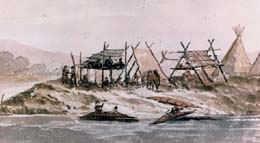In early June 1811, David Thompson (1770-1857), Canadian explorer, geographer, and fur trader, visits a village of Kalispel Indians on the Pend Oreille River, then travels to Spokane House, the North West Company’s trading post at the confluence of the Spokane and Little Spokane rivers, approximately nine miles west of the present city of Spokane. Thompson, a partner with the North West Company of Montreal, has recently pioneered a new trade route across Athabasca Pass in the Canadian Rockies, and brings fresh trade goods for Spokane House. During a four-day visit, he trades with local Spokane bands and makes astronomical observations to calculate the latitude and longitude of the post.
Conversations with the Kalispels
On June 8, paddling down the swollen Pend Oreille River in a leaky canoe, Thompson and a crew of voyageurs reached the upper end of the “Root Plains,” a large camas meadow near present-day Cusick. Here they found several tents of Kalispel Indians, including two men whom they had met in previous years and had dubbed the Little Chief and Haranguer. After learning from these Kalispels that his clerk, Finan McDonald (1782-1851), was at Spokane House, Thompson immediately dispatched his man Cote and an Indian guide with instructions to bring horses to the Pend Oreille camp for the overland route to the Spokane post.
While waiting for Finan McDonald and the pack horses, Thompson hunted waterfowl, exchanged tobacco for roots and a horse to feed his men, and interviewed the Kalispels on their ideas about war, bloodshed, and revenge. Two days of heavy rain further inundated the flooded valley, forcing the travelers to move their camp to higher ground near the modern town of Usk.
Onward to Spokane House
On June 12, Finan McDonald arrived along with three helpers, a Spokane Indian, 13 horses, and a welcome change in the weather. After arranging the cargo on the pack animals, the party set off on a native trail that Thompson called the “Kullyspell Road.” After leaving the flooded Pend Oreille Valley, they reached a stretch of clear woods and grassy plains where they “walked smartly, trotted & Galloped over fine ground” (Thompson, June 13, 1811). On June 14 Thompson had his first view of the post called Spokane House, which had been built the previous year by Jaco Finlay (1768-1828). “Thank Heaven for our good safe journey, here we found Jaco &c with ab[out]t 40 Spokane Families” (Thompson, June 14, 1811).
The following day, a Saturday, the surveyor devoted himself to making observations and calculating the latitude and longitude of the post. The coordinates that he produced were very close to those obtained by modern surveyors.
On Sunday he purchased roots and several dozen “small black carp” (probably suckers) from the Spokane Indians, one band of whom lived near the post. Their village was noted for its fine salmon and steelhead fisheries, but the spring salmon runs had not yet begun, and carp was the only fish available at the time. After securing breakfast, Thompson proceeded to unpack the trade goods he had transported across the continent.
Over the weekend he learned that warriors of the Skeetshoo (Coeur d’Alene) and Shaw pa tin (Nez Perce) were planning to launch an attack on the Tech a new gons (Okanogans). On Monday morning he sent an emissary with gifts of tobacco to find the chiefs of the Coeur d’Alenes and Nez Perce and encourage them to “desist from war” and instead to prepare for war against the Piegan Blackfeet during the fall bison season. Then, complaining that strayed horses had delayed his departure until the late hour of 8:45 a.m., he set off on horseback, bound for Kettle Falls on the Columbia.

